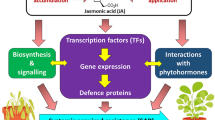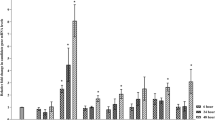Abstract
Key message
TaHIR1 and TaHIR3 play positive roles in resistance to the stripe rust fungus via inducing HR and regulating defense-related genes, but are negatively regulated by various abiotic stimuli.
Abstract
Plant hypersensitive-induced reaction (HIR) genes are known to be associated with the hypersensitive response and disease defense. In wheat, two HIR genes, TaHIR1 and TaHIR3, have been identified and found to be up-regulated after infection with the stripe rust fungus. Here, we further determined their roles in defense against abiotic stresses and the stripe rust pathogen, Puccinia striiformis f. sp. tritici. TaHIR1 and TaHIR3 proteins were localized in the plasma membrane of tobacco cells. The expression of TaHIR1 and TaHIR3 was reduced by the environmental stimuli, including low temperature, drought, and high salinity stresses. In addition, the expression of TaHIR1 and TaHIR3 was down-regulated by exogenously applied ethrel and abscisic acid, whereas expression was not affected by treatments with salicylic acid and methyl jasmonate. Furthermore, barley stripe mosaic virus-induced gene silencing of TaHIR1 and TaHIR3 reduced resistance in wheat cultivar Suwon11 against an avirulent stripe rust pathotype CYR23 and area of necrotic cells neighboring the infection sites, and altered the expression levels of defense-related genes. These results suggest that TaHIR1 and TaHIR3 function positively in the incompatible interaction of wheat-stripe rust fungus, but exhibit negative transcriptional response to abiotic stresses.





Similar content being viewed by others
References
Asthir B, Koundal A, Bains NS, Mann SK (2010) Stimulation of antioxidative enzymes and polyamines during stripe rust disease of wheat. Biol Plant 54:329–333
Atkinson MM, Mildland SL, Sims JJ, Keen NT (1996) Syringolide triggers Ca2+ influx, K+ efflux, and extracellular alkalization in soybean cells carrying the disease resistance gene rpG4. Plant Physiol 112:297–302
Browman DT, Hoegg MB, Robbins SM (2007) The SPFH domain-containing proteins: more than lipid raft markers. Trends Cell Biol 17:394–402
Choi HW, Kim YJ, Hwang BK (2011) The hypersensitive induced reaction and leucine-rich repeat proteins regulate plant cell death associated with disease and plant immunity. Mol Plant Microbe Interact 24:68–78
Dangl JL, Jones JD (2001) Plant pathogens and integrated defence responses to infection. Nature 411:826–833
Delledonne M, Zeier J, Marocco A, Lamb C (2001) Signal interactions between nitric oxide and reactive oxygen intermediates in the plant hypersensitive disease resistance response. Proc Natl Acad Sci USA 98:13454–13459
Fujita M, Fujita Y, Noutoshi Y, Takahashi F, Narusaka Y, Yamaguchi-Shinozaki K, Shinozaki K (2006) Crosstalk between abiotic and biotic stress responses: a current view from the points of convergence in the stress signaling networks. Curr Opin Plant Biol 9:436–442
Greenberg JT, Yao N (2004) The role and regulation of programmed cell death in plant-pathogen interactions. Cell Microbiol 6:201–211
Heath MC (1998) Apoptosis, programmed cell death and the hypersensitive response. Eur J Plant Path 104:117–124
Heath MC (2000) Hypersensitive response-related death. Plant Mol Biol 44:321–334
Hofius D, Tsitsigiannis DI, Jones JD, Mundy J (2007) Inducible cell death in plant immunity. Semin Cancer Biol 17:166–187
Holzberg S, Brosio P, Gross C, Pogue GP (2002) Barley stripe mosaic virus-induced gene silencing in a monocot plant. Plant J 30:315–327
Huber TB, Benzing T (2005) The slit diaphragm: a signaling platform to regulate podocyte function. Curr Opin Nephrol Hypertens 14:211–216
Jones JD, Dangl JL (2006) The plant immune system. Nature 444:323–329
Jones JD, Robert-Seilaniantz A, Navarro L, Bari R (2007) Pathological hormone imbalances. Curr Opin Plant Biol 10:372–379
Jung HW, Hwang BK (2007) The leucine-rich repeat (LRR) protein, CaLRR1, interacts with the hypersensitive induced reaction (HIR) protein, CaHIR1, and suppresses cell death induced by the CaHIR1 protein. Mol Plant Pathol 8:503–514
Jung HW, Lim CW, Lee SC, Choi HW, Hwang CH, Hwang BK (2008) Distinct roles of the pepper hypersensitive induced reaction protein gene CaHIR1 in disease and osmotic stress, as determined by comparative transcriptome and proteome analyses. Planta 227:409–425
Kale SD, Gu B, Capelluto DG, Dou D, Feldman E, Rumore A, Arredondo FD, Hanlon R, Fudal I, Rouxel T, Lawrence CB, Shan W, Tyler BM (2010) External lipid pi-3-p mediates entry of eukaryotic pathogen effectors into plant and animal host cells. Cell 142:284–295
Kang ZS, Li Z (1984) Discovery of a normal T. type new pathogenic strain to Lovrin10. Acta Cllegii Septentrionali Occidentali Agriculturae 4:18–28
Karrer EE, Beachy RN, Holt CA (1998) Cloning of tobacco genes that elicit the hypersensitive response. Plant Mol Biol 36:681–690
Lu ZX, Gaudet D, Puchalski B, Despins T, Frick M, Laroche A (2006) Inducers of resistance reduce common bunt infection in wheat seedlings while differentially regulating defence-gene expression. Physiol Mol Plant Pathol 67:138–148
Mishra S, Murphy LC, Nyomba BL, Murphy LJ (2005) Prohibitin: a potential target for new therapeutics. Trends Mol Med 11:192–197
Molina A, Gorlach J, Volrath S, Ryals J (1999) Wheat genes encoding two types of PR-1 proteins are pathogen inducible, but do not respond to activators of systemic acquired resistance. Mol Plant Microbe Interact 12:53–58
Morel JB, Dangl JL (1997) The hypersensitive response and the induction of cell death in plants. Cell Death Differ 4:671–683
Morrow IC, Parton RG (2005) Flotillins and the PHB domain protein family: rafts, worms and anaesthetics. Traffic 6:725–740
Nadimpalli R, Yalpani N, Johal GS, Simmons CR (2000) Prohibitins, stomatins, and plant-disease response genes compose a protein superfamily that controls cell proliferation, ion channel regulation, and death. J Biol Chem 275:29579–29586
Niu J, Liu R, Zheng L (2007) Expression analysis of wheat PR-1, PR-2, PR-5 activated by Bgt and SA, and powdery mildew resistance. J Triticeae Crops 27:1132–1137
Norman-Setterblad C, Vital S, Palva ET (2000) Interacting signal pathways control defense gene expression in Arabidopsis in response to cell wall-degrading enzymes from Erwinia carotovera. Mol Plant Microbe Interact 4:430–438
Pfaffl MW (2001) A new mathematical model for relative quantification in real-time RT-PCR. Nucleic Acids Res 29:e45
Pieterse CMJ, Leon-Reyes A, Van der Ent S, Van Wees SCM (2009) Networking by small-molecule hormones in plant immunity. Nat Chem Biol 5:308–316
Qi Y, Tsuda K, Nguyen LV, Wang X, Lin J, Murphy AS, Glazebrook J, Thordal-Christensen H, Katagiri F (2011) Physical association of Arabidopsis hypersensitive induced reaction proteins (HIRs) with the immune receptor RPS2. J Biol Chem 286:31297–31307
Rostoks N, Schmierer D, Kudrna D, Kleinhofs A (2003) Barley putative hypersensitive induced reaction genes: genetic mapping, sequence analyses and differential expression in disease lesion mimic mutants. Theor Appl Genet 107:1094–1101
Scofield SR, Huang L, Brandt AS, Gill BS (2005) Development of a virus-induced gene-silencing system for hexaploid wheat and its use in functional analysis of the Lr21-mediated leaf rust resistance pathway. Plant Physiol 138:2165–2173
Tavernarakis N, Driscoll M, Kyrpides NC (1999) The SPFH domain: implicated in regulating targeted protein turnover in stomatins and other membrane-associated proteins. Trends Biochem Sci 24:425–427
Teardo E, Formentin E, Segalla A, Giacometti GM, Marin O, Zanetti M, Schiavo FL, Zoratti M, Szabò I (2011) Dual localization of plant glutamate receptor AtGLR3.4 to plastids and plasmamembrane. Biochim Biophys Acta 1807:359–367
Torres MA, Jones JD, Dangl JL (2006) Reactive oxygen species signaling in response to pathogens. Plant Physiol 141:373–378
Wang CF, Huang LL, Buchenauer H, Han QM, Zhang HC, Kang ZS (2007) Histochemical studies on the accumulation of reactive oxygen species (O2− and H2O2) in the incompatible and compatible interaction of wheat-Puccinia striiformis f. sp. tritici. Physiol Mol Plant Pathol 71:230–239
Wang XJ, Tang CL, Zhang HC, Xu JR, Liu B, Jie LV, Han DJ, Huang LL, Kang ZS (2011) TaDAD2, a negative regulator of programmed cell death, is important for the interaction between wheat and the stripe rust fungus. Mol Plant Microbe Interact 24:79–90
Yu XM, Yu XD, Qu ZP, Huang XJ, Guo J, Han QM, Zhao J, Huang LL, Kang ZS (2008) Cloning of a putative hypersensitive induced reaction gene from wheat infected by stripe rust fungus. Gene 407:193–198
Zhang J, Zhou JM (2010) Plant immunity triggered by microbial molecular signatures. Mol Plant 3:783–793
Zhang G, Dong YL, Zhang Y, Li YM, Wang XJ, Han QM, Guo J, Huang LL, Kang ZS (2009) Cloning and characterization of a novel hypersensitive induced-reaction gene from wheat infected by stripe rust pathogen. J Phytopathol 157:722–728
Zhang H, Wang C, Cheng Y, Wang X, Li F, Han Q, Xu J, Chen X, Huang L, Wei G, Kang Z (2011) Histological and molecular studies of the non-host interaction between wheat and Uromyces fabae. Planta 234:979–991
Zhou L, Cheung MY, Zhang Q, Lei CL, Zhang SH, Sun SSM, Lam HM (2009) A novel simple extracellular leucine-rich repeat (eLRR) domain protein from rice (OsLRR1) enters the endosomal pathway and interacts with the hypersensitive-induced reaction protein 1 (OsHIR1). Plant Cell Environ 32:1804–1820
Zhou L, Cheung MY, Li MW, Fu Y, Sun Z, Sun SSM, Lam HM (2010) Rice Hypersensitive Induced Reaction Protein 1 (OsHIR1) associates with plasma membrane and triggers hypersensitive cell death. BMC Plant Biol 10:290
Acknowledgments
This study was supported by the National Major Project of Breeding for New Transgenic Organisms in China (2011ZX08002-001), the National Basic Research Program of China (No.2013CB127700), the National Natural Science Foundation of China (No. 30930064, 31171795 and 30800712), the 111 Project from the Ministry of Education of China (No.B07049) and the Fundamental Research Funds for the Central Universities of China (QN2009035). We specially thank Dr. Larry Dunkle, U. S. Department of Agriculture-Agricultural Research Service at Purdue University, for improvement of this manuscript.
Author information
Authors and Affiliations
Corresponding authors
Additional information
Communicated by M. Jordan.
Electronic supplementary material
Below is the link to the electronic supplementary material.
Rights and permissions
About this article
Cite this article
Duan, Y., Guo, J., Shi, X. et al. Wheat hypersensitive-induced reaction genes TaHIR1 and TaHIR3 are involved in response to stripe rust fungus infection and abiotic stresses. Plant Cell Rep 32, 273–283 (2013). https://doi.org/10.1007/s00299-012-1361-6
Received:
Revised:
Accepted:
Published:
Issue Date:
DOI: https://doi.org/10.1007/s00299-012-1361-6




